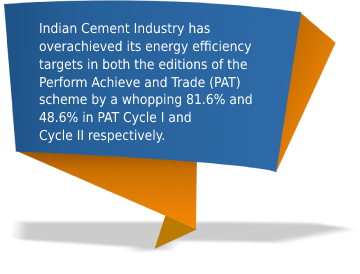India asserted its position as a global climate leader in COP26 when it announced adoption of a net zero emissions target by 2070 and reduction in carbon intensity by 45% from 2005 levels.Indian Industries such as Cement are committed to the national aspiration towards sustainable development. Energy efficiency is the recognised as the least cost pathway to achieving sustainable development. Through adoption of modern technology and process optimisations, the Indian Cement Industry has overachieved its energy efficiency targets in both the editions of the Perform Achieve and Trade (PAT) scheme by a whopping 81.6% and 48.6% in PAT Cycle I and Cycle II respectively.
Perform Achieve and Trade is a regulatory flagship instrument implemented under the National Mission for Enhanced Energy Efficiency (NMEEE) by the Ministry of Power, India. PAT is aimed to reduce the specific energy consumption (SEC) in select energy intensive industries, such as cement, iron & steel, fertilisers and distribution companies among others making them more resource and energy efficient. The PAT scheme incentivises entities through a market based mechanism, wherein Energy Savings Certificates (ESCerts) are issued/bought by the participating entities based on their performance vis a vis the allotted target. Companies, which fail to achieve their respective target, are required to offset the targets through purchase of ESCerts or pay a penalty. On the other hand, the overperforming entities could sell the additional ESCerts to retrieve a portion of capital investment made into latest technologies and process efficiencies.
All Cement integrated plants with an annual energy consumption of over 30,000 toe are eligible for inclusion in the PAT scheme. Such eligible entities are referred to as Designated Consumers (DCs). Table highlights the number of cement plants included for review under various PAT editions.
| PAT Cycle | PAT I | PAT II | PAT III | PAT IV | PAT V | PAT VI |
|---|---|---|---|---|---|---|
| Cement DCs | 85 | 111 | 14 | 1 | 12 | 37 |
| Energy Consumption million toe | 15.01 | 21.432 | 1.743 | 0.074 | 1.605 | 1.241 |
| Energy Savings Target million toe | 0.815 | 1.117 | 0.096 | 0.004 | 0.087 | 0.062 |
| Target Realisation (%) | +81.6% | +48.6%1 |
The overachievement on the allocated targets is a result of meticulous planning, dexterity of business operations and significant capital investment into new technology. The prominent technologies/measures that helped Cement Industry achieve its targets are detailed below2,3
The two cycles of PAT have unlocked potential of the Indian Cement Industry to emerge as a world class manufacturer. The energy savings realised in both the PAT editions are estimated to have resulted in monetary savings of INR 9,500 crore (PAT I) and INR 30,000 crore (PAT II). While cement players have adopted all/portion of the listed prominent technologies/measures, the capital intensive nature of these solutions has somewhat brought down the rate of adoption across the spectrum. While market based mechanisms are yet to pick pace in India, there exists a strong business case to incentivise uptake of modern technology through alternate financial measures such as accelerated depreciation, reduction in import duty, tax rebates and capital subsidy to enable India emerge as the world’s cement manufacturing hub.
